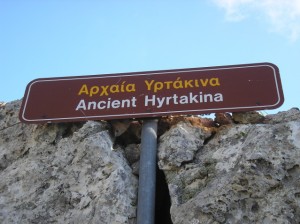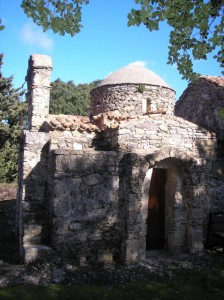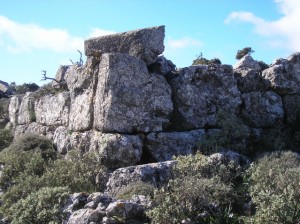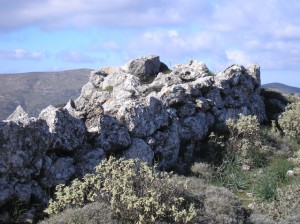High in the hills above Paleohora, just 9 km away as the eagle flies, but twice that and half an hour’s drive through Azogires and Strati to Temenia, is the site of Ancient Yrtakina. Very little has been written about Yrtakina, and much of the following derives from two visits there with our friend the late Tony Fennymore, and his notes to the site kindly made available by his partner Ann.

Yrtakina is thought to have been an ancient city of the Hellenistic era, dating from around 323 BC, and the capital city of the Achaeans of West Crete. Situated at c.900 metres above sea level on a rocky hill called Kastri, its fortress-like position encircled by two ‘Cyclopian’ defensive walls gave security in troubled times. In peaceful periods Yrtakina formed an economic alliance with the neighbouring cities of Elyros, Syia, Tarra, Lissos and Pikilassos (the Confederation of Oreii, 300 BC), and had its own currency.
In 1938-39 excavations revealed a temple from the 4th Cent. BC, dedicated to the God Pan, the protector of shepherds and flocks. A statue of Pan, together with a carved gravestone, is now exhibited in Chania’s Archeological Museum.
A short walk up to, and an exploration of the site makes an interesting day out from Paleohora. Drive to the outskirts of Temenia, turn right towards Maza and Sougia, and park where a sign indicates ‘Ancient Hyrtakina’, with a track off right. This lane also leads to the exquisitely beautiful 13th century church of Christ the Saviour, shaded by trees, and not to be missed.

Now the climbing begins, with 2km/40 mins steadily uphill on a winding track through centuries-old terracing and ever-widening landscapes. The White Mountains peaks of Gingilos and Volakias dominate the view eastwards, with the sea at Sougia over 2000m below. The deep gash of the Agia Irini Gorge is prominent, and the villages of Koustoyerako, Rodovani, and Kamaria.
The track ends at a large boulder of fluted limestone, with a final sign confirming you have reached the site. After that – nothing! Apart from a line of red-painted arrows and dots which, followed carefully, will lead you through the site (via a wire fence) to the radio and other masts on the eastern escarpment.
A word of warning here : make a note of where you entered the site – you need to return to the same point. And don’t venture further if alone or in mist/low cloud – the ‘city’ covers a wide area which can be confusingly similar, and it’s easy to become disorientated.
Wander where you will, although the waymarking will lead past remains of former dwellings, cultivated areas, a well, possible burial tombs, and on to the site of the temple, not far from the masts. If you climb up to the latter, beware of deep and dangerous fissures in the limestone.

The original entrance to Yrtakina, Tony showed us, was up the gentler and easily defended slopes to the SE, where remains of a ‘gatehouse’ still exist. The best examples of the massive walls are to the SW. To the steep north and precipitous east sides, the stronghold was virtually impregnable, but of course everywhere was vulnerable to attack, and Yrtakina was eventually destroyed, probably by the warring Dorian tribes, possibly by the Romans during the invasion and subsequent subjugation of Crete in 69-67 BC.

Enjoy the panorama towards the south coast, where the long and winding road to Prodromi
and on through Anidri is an alternative and adventurous way back to Paleohora, also in view. And later, maybe sitting outside the “Skala”, or strolling along the sea-front, gaze up at Yrtakina, try to imagine life there over two thousand years ago, and reflect on a day’s exploring well-spent.
Footnote
Tony’s unique book – “Fenny’s Chania” – a guided walking tour of the town, is still available from several outlets there, or direct from the UK. See www.fennyscrete.com for details.


1 comments
Hello. Loved your article. A word of warning. http://www.fennyscrete.com is hacked and leads to some kind of Japanese hacked site.. I am trying to find some more information about the ancient Yrtakina, hence loved the idea of the tour guide Fennys Chania. Will try to find it over the tour shops in Chania. I am writing an article for my website http://www.sougiataxi-meletis.gr . I’d love a backink if you think thats helpfull and possible. Take care